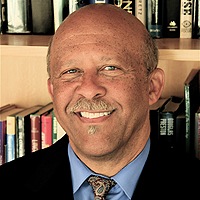
For more than 10 years, the Online Journalism Review was published by the Annenberg School for Communications at the University of Southern California as a place to follow the struggles and triumphs in the nascent field of online journalism. But on June 16, editor Robert Niles posted a note to the site titled, Goodbye, explaining that USC was suspending publication of OJR and that he would be leaving the school.
Quickly, that post filled up with comments of support from readers who were upset about OJR being shut down and wondering what happened behind the scenes. Anthony Moor, deputy managing editor of interactive at the Dallas Morning News summed up much of that feedback with his comment: “It’s a shame USC has decided to shutter one of the best sites helping journalists navigate the transformation of our industry today. I guess the big question is…why?”
The short answer is that the Annenberg School is going through a major transition, with a new dean, Ernest Wilson, and a new director of the journalism school (which lives within the overall school of communications), Geneva Overholser. They are reconsidering many programs, and want to rethink the way that OJR operates at the school.
“We reached a point where that initial enthusiasm [for OJR] has drifted away,” Wilson told me. “We don’t have a full-time [online journalism] program at this point, we have a lot of people teaching online journalism stuff, and we’re getting a new director at the school of journalism. I decided we need to bring on board two, if not three, full-time people just to teach how one reports and writes using [the online] platform…We’re taking a half-step back, taking a deep breath and figuring out how we want to move forward with [OJR].”
But there’s a larger story behind the rise and fall (and possible rebirth) of OJR, relating to academia and its own struggles putting online journalism into curriculum in a meaningful way. Plus, I have first-hand experience working as a freelance columnist for OJR from 2001 to 2005, having had three different editors in that time, while noticing the deteriorating backing from the Annenberg School administration. Niles was brought on as editor in 2004, and immediately noticed a change at OJR.

“I got the sense that they almost killed [OJR] when I got there,” Niles told me. “There used to be a big suite of offices on the first floor, and then when I came in they moved me to one little office in the basement. Then they moved me off-campus and into a smaller office this past year. They kept moving me farther and farther away…The budget for OJR got cut every year. There’s less and less money to pay for writers, to the point of which this last year there was nothing beyond my own salary and a grad student research assistant, which is basically a scholarship. I used to have two but they cut it down to one.”
Eric Ulken is a former grad student editor at OJR who now is editor of interactive technology at LATimes.com. He backs up Niles’ view of what was happening at OJR and how things changed, and gives Niles credit for doing a lot with little backing.
“When I arrived at Annenberg in 2004 (my decision to enroll in grad school there based in large part to OJR’s presence), the site occupied a choice office in the space-strapped Annenberg building,” he told me. “There was a small army of student editors and contributors, and I was fortunate to snag an assistantship working for OJR and its sister publication, Japan Media Review (which was shut down when its grant ran out a couple years ago). In early 2004, the school moved OJR into a cramped basement office to make room for the newly founded Center on Public Diplomacy. That’s when Robert was brought in, and I think he did an admirable job of making the site more reader-focused, rewriting the creaky CMS [content management system] from the ground up — by himself — to introduce wiki functionality and make the [site] more blog-like.”
Geoffrey Cowan, the former dean at Annenberg School, said he had grand ambitions for OJR, hoping it would follow in the footsteps of the Columbia Journalism Review, which Cowan’s father helped to found. Cowan told me via email that he didn’t think OJR’s budget was cut so much by Annenberg, but that the site lost outside foundation funding and that some money was moved into other digital initiatives.

“As the school has grown, of course, we have put resources into other new related programs such as Pop + Politics, the Knight Digital Media Center, and the Center on the Digital Future, so that we were and are almost certainly putting much more money into various aspects of online journalism and doing more in that area…So far as I know, the program continued to have quite a bit of student support.”
The New Dean and His Challenges
But while Cowan was a big fan of creating “centers” at Annenberg School — there are now 14 of them — the new dean, Ernest Wilson, is trying to find more ways for disparate groups to work together more closely at the school. He believes that OJR played an important role in covering the early days of online journalism, and vows to keep the archives alive and online. But he wants the new OJR to go beyond Niles’ one-man-band approach.
“Online Journalism Review played a critical role in the early days of looking at how journalists can operate across platforms and the lessons they’ve learned,” Wilson said. “And it clearly made a big contribution at a point in time…I don’t want to pre-judge [the new direction for OJR]. We [produce] a live TV broadcast four nights a week, and you go down there and it looks like an affiliate for a real news broadcast, and we do something similar for radio. And we are thinking how we extend that onto digital platforms so people have real-time experience in writing across multiple platforms. OJR could play a role in that.”

One of the biggest challenges for OJR is that there is no dedicated online journalism program at Annenberg School and no faculty that specialize in online journalism. At one point, longtime OJR administrator Larry Pryor was an online journalism professor, but he was moved into environmental journalism and other research projects. Now, Wilson’s charge is to hire two or three new faculty with online experience. The problem he will have is one that has dogged journalism schools: How do you attract faculty in a nascent field where they can make more money in the private sector?
“It’s hard to get senior, tenure-able faculty in a field that’s barely 10 years old,” Niles said. “It’s always been a little bit difficult in journalism because so many people in it are professionals in the field and not getting PhDs. We’ve always been a field that’s light on PhDs. I know [Annenberg School] was looking at some people for online but they couldn’t get tenure for them. And I looked at those names and said, ‘If you can’t get tenure for those people, you can’t get tenure for anyone in online.’ I’ve heard the same from people at other schools, so you have to be willing to be taking people and put them on the tenure track earlier…That’s a tough process.”
Niles notes that OJR suffered mightily because of the lack of faculty dedicated to online journalism. The way he puts it: “Without an online journalism faculty, there wasn’t enough soil for this plant to grow in.” Even the Annenberg School at USC, with its $100 million grant from the Annenberg Foundation in 2002, suffers from the same problems as the media institutions it’s training students to join: resistance to change.
“You have so much inertia,” Niles said. “You think newspapers turn around slowly? Universities turn around even more slowly than that. Everybody’s having this trouble. How do you build an online university faculty? Even if you have people and you can give them tenure, you still have to compete on salary and benefits, and people who can really do this are really in demand…What’s been happening at USC is by no means unique. They threw a lot of money up front to try to buck that trend, but for various institutional reasons that played out before I got there, it didn’t take root so that it could keep growing over the years.”
A New Home at the Knight Center?
It would be pure pain for Niles to see OJR finally get the attention and backing it deserves at Annenberg School — but with him out of the picture. Still, the future of the site and its place at the school are still being decided. Vikki Porter, the director of the Knight Digital Media Center at USC, said she’s trying to keep OJR alive in an interim home at the Knight Center’s site. That might make sense as OJR and the Center both have an interest in informing and training new media professionals.
Porter recently sent me this update on what’s in the works:
At Geneva Overholser’s urging and with Dean Wilson’s blessing, Robert Niles and I are working on an arrangement that will allow us to keep the Online Journalism Review alive as a blog housed under the Knight Digital Media Center umbrella. Our hope is that we can use the blog and the time to refocus its future mission and also, frankly, figure out a sustainable funding mechanism.
Robert will edit the blog as well as contribute and we will seek guest bloggers, addressing questions that are more horizon-looking. This will still allow us to undertake the “strategic assessment” and keep OJR’s voice alive. Details are still being worked out (this being a university environment where approvals go through a lot of hands), but my hope is that we would be able to launch the blog on the KDMC website by the end of the month.
But as Niles has pointed out to me, there’s a danger of losing momentum for OJR even if it’s closed for a few months — or has to move around to different sites. Readers would have to update their bookmarks, RSS feed readers and regular browsing habits, and it’s difficult to show loyalty for a site that’s in limbo or shifting locations.
The problem for OJR is a common one in the online world: It faces more competition from sites such as Poynter, PaidContent and even CJR as it covers more online journalism. Even the term “online journalism” loses its niche status when every type of journalism ends up having an online element and convergence happens. The saddest part of the OJR story is that it was a site ahead of its time, focused on one of the most transformative events in the history of journalism — and yet, it lost the institutional backing of the university that housed it.
Elizabeth Osder, an editor and consultant that worked with OJR from 2002 to 2004, thinks that OJR may have outlived its usefulness, but believes that OJR’s credibility and influential audience was a lost opportunity for the school.
“OJR represented a tremendous opportunity to bridge the academy with the profession by providing a solid link between the excellence of Annenberg’s scholarly work to a professional community with real data, use cases and in need of deeper thinking, analysis and research,” she said via email. “Moving forward, linking OJR’s mission, archive and most importantly its professional audience to Annenberg’s other assets seems to be the real opportunity.”
As the incoming dean Ernest Wilson told me “I am honestly looking for good ideas,” so here are a few I have for how OJR might be revived at Annenberg School:
> Hire dedicated faculty with a charge to make digital and online journalism a part of every facet of the journalism education at the school.
> Assign faculty, grad students and students to help write for, edit and moderate how-to guides and discussions at OJR about the transition to digital media.
> Create more community spaces — in the virtual and real world — for the Annenberg School to collaborate with professional journalists, technologists, academics and other people who work and study digital media.
> Raise the profile of OJR within the school so that there is more internal visibility for the work it does.
> Do more than just text reports on OJR. Become a test-bed for cross-platform, multimedia reporting and include citizen journalism, podcasts and crowdsourcing so that professionals can see what works and what doesn’t.
What do you think? What can the Annenberg School do to revive OJR, and make it a more vital place to discuss online journalism? What did you like about the site and what could be improved? Share your thoughts in the comments below.
UPDATE: Howard Owens makes a great point about a missing angle in my story: The days when OJR was a lively read with Matt Welch and Ken Layne mixing it up. As Owens says:
If OJR is worth saving, it’s worth remembering what it was like in the Welch-Layne era and maybe trying to recapture that spirit. Online journalism could use some free-spirited iconoclasts now more than ever. I don’t think Niles was ever given the opportunity or the resources to continue on in the tradition of Layne and Welch, which makes it all the more vital to remember the golden era of OJR if there’s going to be any talk of bringing back.
I agree that OJR could use an injection of personality, similar to what it had in the old days. We’ll see if that’s part of the rebirth of the site.

I’m afraid this is just another example of how little regard the academic community for life in the real world. Until its budget was cut to nearly nothing several years ago, OJR was the site to learn about the dizzying changes taking place in the world of new media and online journalism.
Now, readers will have to go somewhere else to figure it out, and USC students will be all the poorer for not being able to have hands-on experience with online journalism as it reinvents itself for the age of social media.
Disclaimer: I was a columnist and writer at OJR from 1998 to 2005.
Every journalism school faces the challenge of changing to adapt to the evolving nature of journalism in a digital environment. And it is true that part of the challenge is finding the right people, or “senior, tenure-able faculty”, in such a new field.
As someone who has made the transition to the academy after 20 years in journalism, almost half of them in online journalism, I can understand the dilemmas.
I was brought on by the UBC Graduate School of Journalism largely due to my online experience. But rather than create a separate stream in online journalism, we have sought to integrate our journalism courses.
This past academic year, we rolled out an innovative and ambitious team-taught multiplatform journalism course that forms the core of the first-year of a two year Masters program. Our approach is to prepare students to work across media – print, broadcast and online – with an understanding of the strengths and weaknesses of these different platforms.
This approach requires a great deal of coordination and cohesion among faculty but it has paid off in the quality of the student work.
I’d be happy to share our experiences and get some feedback on how we can revitalise journalism education for a digital era.
Annenberg should let OJR go. The interest, enthusiasm is apparently gone. And the name is dated. Online? As opposed to what? Should it be revived is the wrong question; what follows next is the more important one, and it seems as if that’s being talked about.
I expect Annenberg will continue to deliver great things to journalism. Of that I have zero concerns.
It will be a waste of resources to rebuild or prop up a standalone site for online journalism. The integrative content approach combining all platforms (print/television/web/mobile) is the direction the communications industry is heading.